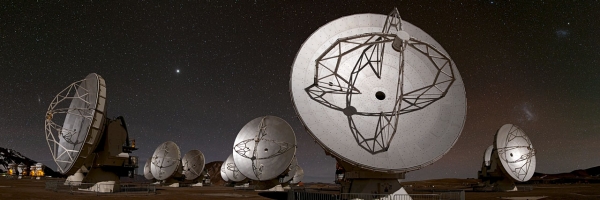ALMA Community Days 2012: Early Science in Cycle 1
ESO Garching, June 25-27, 2012

ALMA, the Atacama Large Millimeter/submillimeter Array, is expected to be the leading observatory at millimeter and submillimeter wavelengths over the coming decades. A global collaboration involving Europe, North America, East Asia and the host country Chile, ALMA is currently carrying out first scientific observations for the astronomical community, while construction and commissioning activities are ongoing. The array is located at a unique 5000-m high site in the northern Andes and will count 66 high-precision antennas equipped to observe at the frequency range from 85 GHz to 1THz. The interface between ALMA and its potential users is provided by the local ARC (ALMA Regional Centre). In Europe, the ARC consists of a network of regional ARC nodes coordinated by the central European ARC hosted at ESO Headquarters in Garching, Germany.
ALMA Early Science Operations started with Cycle 0 in September 2011. Nearly 1000 proposals were received from scientists around the world, around one tenth of which were scheduled for observation. Although the technical capabilities offered in Cycle 0 are limited compared to those envisaged for Full Science Operations, the data obtained are already of remarkable accuracy and quality. In Cycle 1, an enhanced set of ALMA technical capabilities and a larger array of antennas will be offered to the astronomical community. While the building and commissioning of the full array will continue throughout this observing cycle, the fraction of time available for Early Science observations is expected to increase as the array nears completion. Adding to this the higher sensitivity and technical capacity of the array, ALMA in Cycle 1 has the potential to yield ground-breaking scientific results largely surpassing those achievable using existing facilities.
The European ARC will host a 2-3 day workshop entitled "ALMA Community Days: Early Science in Cycle 1" from 25-27 June 2012 at ESO Headquarters in Garching. The aim is to prepare the European Astronomical Community for Cycle 1 of ALMA Early Science Operations. The first day will feature a series of technical and scientific presentations related to ALMA, the European ARC and capabilities in Cycle 1. The remainder of the workshop will be dedicated to hands-on tutorials focussing on the preparation of Cycle 1 observing proposals using the ALMA Observing Tool (OT). Depending on their level of expertise, the workshop participants will be given the choice of attending either a compact 1-day tutorial or a more exhaustive 2-day session. This should enable novice and advanced ALMA users alike to create observing projects making full use of the unique capabilities of ALMA during Cycle 1.
